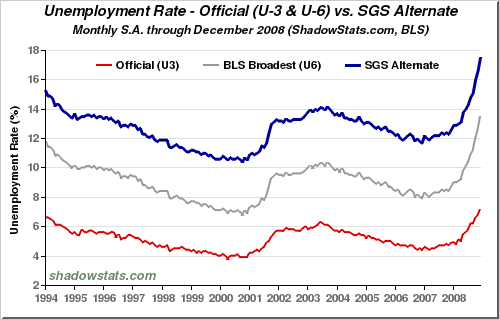Logical minds are questioning the wisdom of US stimulus (deficit) spending. We have already seen the end results of excessive borrowing and spending by the State of California – see California Defaults.
Global Worries Over U.S. Stimulus Spending
DAVOS, Switzerland — Even as Congress looks for ways to expand President Obama’s $819 billion stimulus package, the rest of the world is wondering how Washington will pay for it all.
“The U.S. needs to show some proof they have a plan to get out of the fiscal problem,” said Ernesto Zedillo, the former Mexican president who helped steer his country through a financial crisis in 1994. “We, as developing countries, need to know we won’t be crowded out of the capital markets, which is already happening.”
While the focus in Washington has been on putting together a stimulus package that will attract broader political support when it comes up for a vote in the Senate, here in Davos the talk has been about the coming avalanche of Treasury debt needed to pay for the plan on top of the bailout measures approved last fall, like the $700 billion Troubled Asset Relief Program, or TARP.
American officials maintain they are aware of the challenge. A top White House adviser, Valerie Jarrett, promised in Davos on Thursday that once the stimulus plan achieved its intended affect, the United States would “restore fiscal responsibility and return to a sustainable economic path.”
“Even before Obama walked through the White House door, there were plans for $1 trillion of new debt,” said Niall Ferguson, a Harvard historian who has studied borrowing and its impact on national power. He now estimates that some $2.2 trillion in new government debt will be issued this year, assuming the stimulus plan is approved.
“You either crowd out other borrowers or you print money,” Mr. Ferguson added. “There is no way you can have $2.2 trillion in borrowing without influencing interest rates or inflation in the long-term.”
“This is a crisis of excessive debt, which reached 355 percent of American gross domestic product,” he said. “It cannot be solved with more debt.”
While Mr. Ferguson is a skeptic of the Keynesian thinking behind President Obama’s plan — rather than borrowing and spending to stimulate the economy, he favors corporate tax cuts — even supporters of the plan like Mr. Zedillo and Stephen Roach of Morgan Stanley have called on the White House to quickly address how it will pay for the spending in the long-term.
The stimulus is widely expected to pass, but once it does, Mr. Roach said the focus would shift to “who foots the bill and what is the exit strategy. We don’t have the answer to either question.”
Mr. Zedillo, who remembers how Mexico was forced to tighten its belt when it received billions from Washington to keep its economy from collapsing in 1994, was even more blunt.
“People are not stupid,” Mr. Zedillo said. “They see the huge deficit, the huge spending, and wonder what comes next.”
US Should Take Its Own Advice
We could not come close to achieving fiscal responsibility when we did not have a financial crisis. It is absurd to think that “at some future date” we will do so. There is no easy solution to our financial nightmare. The attempt to postpone and paper over the debt crisis with additional borrowed or printed money merely guarantees a bigger problem down the road.
Mr. Zedillo, former Mexican President, notes that his country was told by America to “tighten its belt when facing financial collapse”. Is the United States exempt from the same logic? Why are we not taking the same advice we force upon others?

